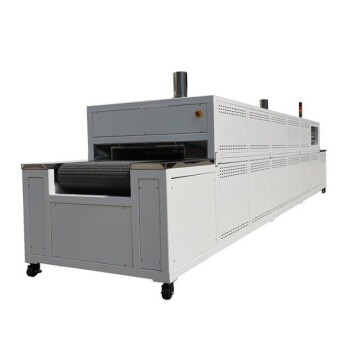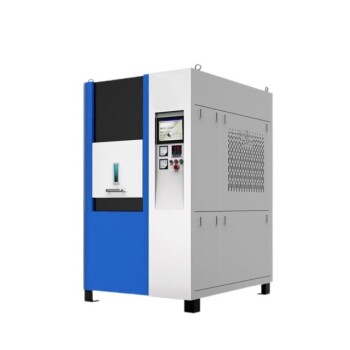In short, MPCVD technology is considered versatile and important because it provides an unparalleled level of control and purity when synthesizing diamond. This precision allows engineers to unlock diamond's exceptional properties—such as extreme hardness, thermal conductivity, and biocompatibility—for a wide array of high-performance applications, from next-generation semiconductors to advanced medical implants.
The true value of MPCVD lies not just in its ability to create diamond, but in its unique capacity to create it cleanly and controllably. This process overcomes the limitations of other methods, making the theoretical potential of diamond a practical reality for critical industries.

The Core Mechanism: Why MPCVD Excels
To understand MPCVD's versatility, you must first understand how it works. The method uses microwave energy to excite gases into a plasma state, providing an ideal environment for diamond crystal growth. This core mechanism gives it three fundamental advantages over other techniques.
It Avoids Contamination
Unlike other methods that use hot filaments or electrodes inside the reaction chamber, MPCVD (Microwave Plasma Chemical Vapor Deposition) generates its plasma using microwaves from an external source.
This "electrodeless" nature is critical. It eliminates a primary source of contamination, ensuring the resulting diamond film is exceptionally pure and free from unwanted metallic impurities that degrade performance.
It Offers Precise Environmental Control
MPCVD systems allow for fine-tuned control over all critical growth parameters: temperature, pressure, and gas composition.
This stable and highly controllable environment enables operators to tailor the diamond's properties for specific applications. Whether the goal is a perfectly clear optical window or a tough industrial coating, MPCVD provides the knobs to turn.
The Result: High-Quality, Large-Scale Diamond
The combination of a pure environment and precise control allows for the growth of large, single-crystal diamonds with near-perfect lattice structures.
This capability is essential for demanding applications like semiconductor wafers and high-power optics, where defects and grain boundaries would cripple device performance. MPCVD is the leading method for producing industrial-scale, high-quality diamond.
Where Precision Matters: Key Industry Applications
The high-quality diamond produced by MPCVD enhances performance and reliability across a spectrum of advanced fields.
Electronics and Heat Management
Diamond is the best thermal conductor known to man. MPCVD-grown diamond acts as an ideal heat sink for high-power electronics and CPUs, preventing overheating and improving reliability. Its electrical properties also make it a promising substrate for next-generation semiconductors.
Optics and Lasers
High-purity diamond is transparent across an incredibly broad range of light wavelengths, from ultraviolet to far-infrared. This makes it a superior material for durable windows, lenses, and components in high-power laser systems.
Manufacturing and Cutting Tools
By coating cutting tools and industrial drills with a thin layer of MPCVD diamond, their lifespan and performance can be dramatically increased. The coating provides a surface of extreme hardness and low friction, enabling faster and more precise machining of tough materials.
Biomedical Devices
Diamond is biocompatible and extremely durable. These properties make it an excellent material for medical implants, such as joint replacements or dental devices, as it does not corrode or trigger an adverse reaction from the body.
Understanding the Trade-offs
No technology is without its compromises. While MPCVD is superior in quality, it's important to understand its practical limitations.
Equipment Cost and Complexity
MPCVD systems are sophisticated and represent a significant capital investment. The microwave generators, vacuum chambers, and control systems are more complex and expensive than those used in simpler methods like Hot Filament CVD (HFCVD).
Slower Growth for Ultimate Quality
Achieving the highest crystal quality and purity often requires slower, more deliberate deposition rates. For applications where bulk is more important than perfection, other faster but "dirtier" methods may be more cost-effective.
Process Expertise Required
Operating an MPCVD system to its full potential requires significant process knowledge and expertise. It is not a "plug-and-play" technology; dialing in the correct parameters for a specific outcome is a highly technical skill.
Making the Right Choice for Your Goal
Your choice of diamond synthesis method depends entirely on the performance and cost requirements of your application.
- If your primary focus is ultimate purity and performance (e.g., semiconductor substrates, quantum sensors): MPCVD is the definitive and often only viable choice.
- If your primary focus is cost-effective hard coatings where some impurities are acceptable (e.g., some abrasive tools): Simpler methods like HFCVD can be a pragmatic alternative, though with a clear trade-off in quality.
- If your primary focus is producing large volumes of polycrystalline diamond for less demanding uses: Other high-rate deposition techniques might be more suitable, sacrificing crystal structure for speed.
Ultimately, MPCVD's importance stems from its unique ability to translate the remarkable theoretical properties of diamond into tangible, reliable, and high-performance technological solutions.
Summary Table:
| Aspect | Why MPCVD Excels |
|---|---|
| Purity | Electrodeless plasma avoids metallic contamination. |
| Control | Precise tuning of temperature, pressure, and gas composition. |
| Quality | Enables growth of large, high-quality single-crystal diamonds. |
| Key Applications | Electronics, Optics, Cutting Tools, Biomedical Devices. |
Ready to integrate high-purity diamond synthesis into your R&D or production?
Leveraging exceptional R&D and in-house manufacturing, KINTEK provides diverse laboratories with advanced high-temperature furnace solutions. Our product line, including Muffle, Tube, Rotary Furnaces, Vacuum & Atmosphere Furnaces, and CVD/PECVD Systems, is complemented by our strong deep customization capability to precisely meet unique experimental requirements like MPCVD.
Contact our experts today to discuss how our MPCVD solutions can help you achieve unparalleled material performance.
Visual Guide

Related Products
- Multi Heating Zones CVD Tube Furnace Machine for Chemical Vapor Deposition Equipment
- Custom Made Versatile CVD Tube Furnace Chemical Vapor Deposition CVD Equipment Machine
- 1700℃ High Temperature Laboratory Tube Furnace with Quartz or Alumina Tube
- Inclined Rotary Plasma Enhanced Chemical Deposition PECVD Tube Furnace Machine
- Slide PECVD Tube Furnace with Liquid Gasifier PECVD Machine
People Also Ask
- What customization options are available for CVD tube furnaces? Tailor Your System for Superior Material Synthesis
- What are the advantages of CVD tube furnace sintering systems? Achieve Superior Material Control and Purity
- What are 2D heterostructures and how are they created using CVD tube furnaces? Unlock Atomic-Scale Material Engineering
- How are hexagonal boron nitride (h-BN) films processed using CVD tube furnaces? Optimize Growth for High-Quality 2D Materials
- How can integrating CVD tube furnaces with other technologies benefit device fabrication? Unlock Advanced Hybrid Processes



















